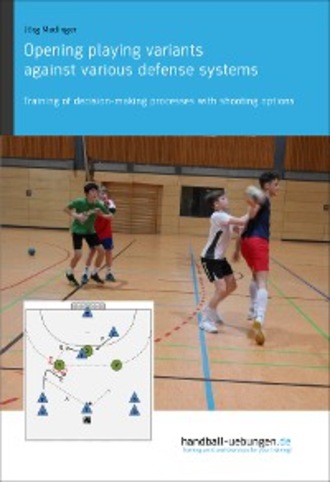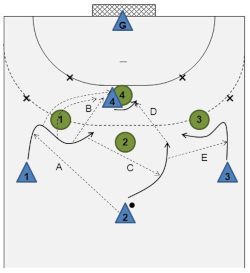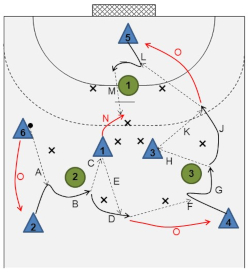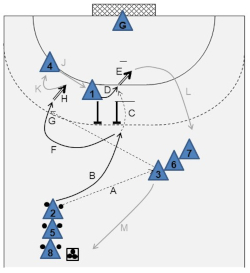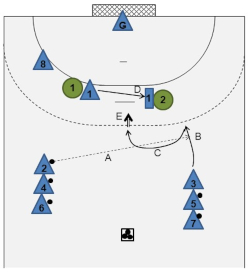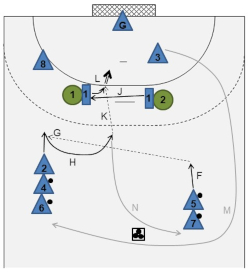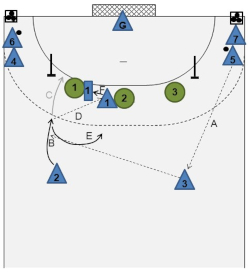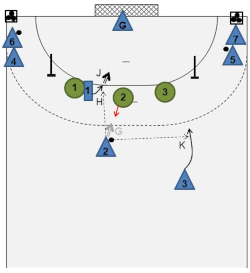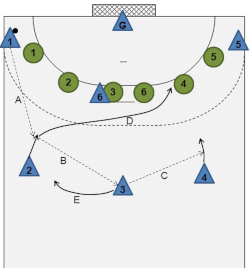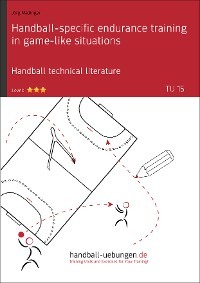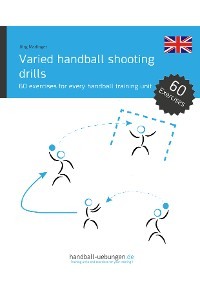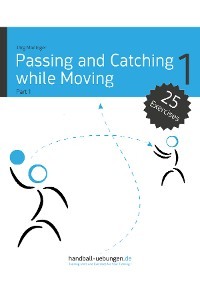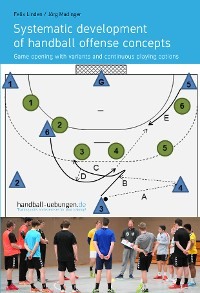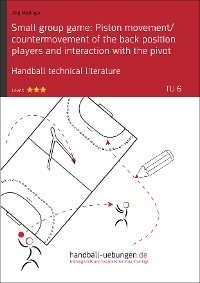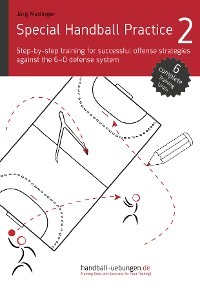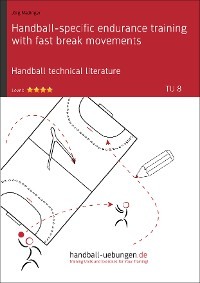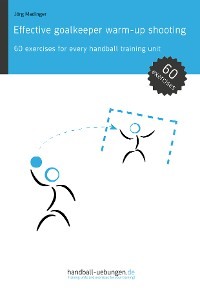- Afterwards, the players repeat the course on the other side.
may take a short break;
places the screen next to
(F).
A3.4 Implementation: Interaction of the back position players with the pivot
Setting:
- Define the playing field with four cones as shown in the figure.
- The players play 4-on-4.
-
, , and defend at the 9-meter line. -
is allowed to move within the zone between the cones only. -
, , and must not run behind the defense line (second pivot).
Course:
- The players further develop the passing variants they practiced before.
-
plays the initial pass to , who moves to the left and then starts a 1-on-1 action (A). → While doing so, he should check whether
is in a good position to receive a pass (B). - If a pass to the pivot is not possible,
passes the ball to (C). -
should now clearly move to the right and may potentially pass the ball to , who moves to the other side of in order to place a screen (D). - If this is not possible, the ball should be passed to
(E), who also should check whether is in a good position to receive a pass. - If
cannot pass the ball to the pivot, the four attacking players may keep playing freely and try to break through 1-on-1 or interact with to score a goal. - If
receives a direct pass resulting in a goal, the respective attacking team gets two points. - Each team may play seven attacks. Which team has scored highest in the end?
Adjust the size of the playing corridor in such a way that the attacking team has some advantage due to the large spaces.
A4: Interaction of the back position players with the pivot to overcome defensive defense formations
Recommended for overcoming these defense systems: 6-0
Requirement:
Description:
In this series of exercises, the players further develop their team play in depth by switching to a 4-2 offense system with two pivots. Following this, they will use shifting movements on the back positions and switched pivot screenings.
Factors of success for the pivot:
- Ideal positioning close to the defense player to block defense movements, but also to create direct shooting situations.
- Picking up the ball and shooting under pressure.
- Catching the ball with one hand.
Factors of success for the back position players:
- Dynamic shifting.
- Decision-making: Direct shot/breakthrough, parallel pass, interaction with the pivots.
Implementation:
This sequence is particularly suitable when playing against more defensive defense systems or against defense systems that act more offensive (3-2-1 defense), but move back to 6-0 as soon as one of the back position players moves to the 6-meter line in order to play as second pivot.
A4.1 Preparatory exercise 1: Ball familiarization with passing to the pivot
Setting:
- Put three cone goals on the gym floor, so that you get a triangle.
- Put another three cones on the floor, in triangular form in the center of the triangle (see figure).
- There is one defense player in each cone goal, and one offense player each standing in front of the goals.
- Two players (
and ) are the pivots and start at the smaller triangle. -
is the feeder/receiver; the remaining players line up behind .
Course:
-
initially passes into the running path of (A), moves to the right (B), and passes the ball past (C), to . - Immediately after the pass,
runs around the cone on the right (D), and receives a return pass from (E). -
then passes to , into his running path (F). also moves to the right (G) and “pushes” the ball through, to (H). -
runs around the right cone of his cone goal (J) and receives a return pass from (K). -
passes into the running path of (L). moves to the right and “pushes” the ball through to (M), who has moved to the respective cone behind the cone goal in the meantime (N), and so on. - As soon as they have passed the ball to the moving attacking player, the players should move to his initial position (O).
The defense players should act defensively and allow the pass. Change the defense players and the players in the center of the triangle. Change the playing direction after some time. The players should then move to the left, “push” the ball through on the other side, and then run around the left cone of the respective cone goal, before eventually receiving the return pass.
A4.2 Preparatory exercise 2: Goalkeeper warm-up shooting via the pivot position
Setting:
- Position two poles to define the running paths.
Course:
-
starts with two balls. initially passes one of the balls to (A). - Afterwards,
dribbles the second ball while running to the inner side, towards the right side of the poles (B). -
“pushes” the ball through to at the 6-meter line (C), picks up the ball (D), and shoots at the right side of the goal as instructed (hands, top, bottom) (E). - Immediately after the pass,
runs a curve to the left (F), and receives the ball from , into his running path (G). -
shoots at the left side of the goal, as instructed (H). - After the pass from
to , starts the next round by passing the ball to . moves to the 6-meter line as the pivot (J). - After the shot,
lines up for the pivot position (K), lines up for the feeder/receiver position (L), becomes the attacking player with two balls (M). The players should concentrate and fulfill their tasks in such a way that the goalkeeper receives a quick series of two shots, but is able to get in a proper position to save them. Also do the course on the other side after a few rounds.
A4.3 Preparatory exercise 3: Piston movements and counter movements with a pass to the pivot and a shot at the goal
Setting:
- Two players play defense.
(Figure 1)
Course:
-
initially passes the ball to (A), into his broad piston movement path (B). -
feints a stem shot and then dynamically moves to the center (C) (if necessary, he may dribble the ball with the hand that is further away from the defense line, with the left hand in the example). - At the same time,
places a screen on the inner side, next to (D), to obstruct the way for to the center. -
eventually shoots at the goal from the back position (E).
(Figure 2)
- After the shot,
starts the piston movement on the right (F) and passes the ball to , into his broad piston movement path (G). -
feints a stem shot and then dynamically moves to the center (H) (if necessary, he may dribble the ball with the hand that is further away from the defense line). - With the stem shot,
moves and places a screen on the inner side, next to (J). - After moving to the center,
passes the ball to the pivot (K); catches the ball and shoots from the pivot position (L). - Afterwards, the players start the next round, with
playing on the pivot position. The pivot should keep screening for as long as possible and leave the screening position (in order to catch the ball) as late as possible. Make sure the pivot maintains a proper screening posture. Also do the course on the other side after a few rounds.
A4.4 Implementation: Interaction 3-on-3
Setting:
- Define the playing field with two poles.
-
, , and as the pivot initially play 3-on-3 against , , and .
(Figure 1)
Course:
- The receivers (
or ) initially pass the ball (A). -
does a broad piston movement and receives the ball from into his running path (B). positions himself next to , placing a screen. -
may then try to break through (C) or pass the ball to on the pivot position (D), if the latter was able to gain positional advantage over . - If neither option is possible,
moves to the inner side (E), and places a screen on the inner side, next to (F).
(Figure 2)
- If
remains passive, may shoot after having moved to the center (G), or pass the ball to (H), who leaves the screening position (J), or play a parallel pass to (K). - The back position players may also pass the ball to the feeders/receivers in order to start the course over.
- As soon as an attacking player has shot at the goal or the defending team has won the ball,
and move to the back positions and the course starts over. Change the defense players and the pivot regularly.
A4.5 Implementation: Interaction 6-on-6
(Figure 1)
Course:
- Two teams play against each other 6-on-6.
- The attacking team always starts the sequence below and then keeps playing until a player has shot at the goal or lost the ball.
- Switch the tasks after 10 attacks each.
- Which team has shot the most goals?
Initial action:
- The wing player passes the ball (A) to the back position player.
-
passes to (B), to (C). 